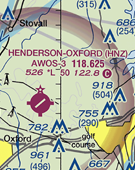Be Careful of GPS
I came back recently from Myrtle Beach, S.C., to Raleigh Durham, N.C., in a Cessna 150 with a single nav/com radio, in solid instrument conditions, and terminating in a 600-1 VOR approach.
Back in the early days of my flying career, IFR flights were regularly flown with one nav/com radio. The addition of a second nav/com, with a glideslope, and marker beacon receivers was a luxury that many instrument pilots enjoyed. Radar coverage was minimal, and controllers depended on position reports and checkpoint estimates from pilots to keep airplanes separated.
The interesting thing is that even today instrument flights can still be conducted safely with just this equipment, but things were so much easier then.
By my quick count, I figure seven major additions, such as DME and Loran, have become available in the last 40 years to make navigation easier. Of them all, only those providing area navigation really add any additional capability to what I had in that Cessna 150.
Now, comes the GPS, a wonderful piece of equipment, but one that takes more time and management to use properly. The problem I’ve seen on instrument flight tests, proficiency checks and training is that pilots depend too much on GPS, and get into trouble trying to force its use. During a recent flight test, the applicant had filed direct to a nearby airport using GPS. His initial clearance was cleared as filed. Then, when he got airborne, the clearance was amended to intercept a radial from a nearby VOR. He wanted to use the GPS to set this up. This was going to take time.
He started to scroll through the database for the VOR. He then had to set up the VOR radial, and then had to figure the intercept. While doing all of this, he actually flew through the radial. He also managed to lose 300 feet and turn 60°, the beginning of a nice spiral.
The easy way, requiring less time and management, would have been to tune the VOR to a nav radio, set up the radial and intercept it. But he tried to force the use of the GPS, which was not necessary.
During another, a recent instrument proficiency check under actual instrument conditions, the pilot had been told to expect an ILS approach and was on vectors for the approach. Then the situation changed. Traffic suddenly flooded the airport and he was directed to proceed to a nearby VOR and hold. The easy thing would have been to tune a nav radio to the VOR and proceed direct. But no, he wanted to use his GPS, which took considerably more time to set up.
Now, it is one thing to allow a pilot to make a mistake in good VFR conditions, but something totally different in IFR and heavy traffic. While he was playing around with the GPS, I tuned to the VOR, set the OBS and got us going in the right direction.
VFR pilots also abuse the use of GPS. We’ve all heard of pilots jumping into airplanes, setting up direct routes to their destinations and then flying right into restricted airspace. They throw pre-flight planning to the wind and rely solely on GPS to get them to their destinations, often suffering extreme vulnerability to TFRs, which are often created after the most current update to the GPS database. Also, many VFR-only GPS units are not updated as regularly as those approved for IFR. I only update my little hand-held GPS once a year.
Because of the tremendous capabilities of GPS, they are more complex than our previous navigation systems and frankly harder to set up for many functions. This can increase work load and distraction, especially in single pilot operations. Since few small airplanes are equipped with dual GPS, the pilot who puts too much reliance on GPS leaves himself with little or no redundancy unless he has maintained a high degree of proficiency with other types of navigation such as VOR, ADF and even pilotage and dead reckoning.
For most GA pilots, the addition of GPS adds only one true capability — and that is direct flights. Otherwise there is nothing the GPS does that could not be done without it.
In no way do I want to criticize the development of GPS. I think it is a wonderful piece of equipment. I just want pilots to understand that it is a navaid, not a crutch. The pilot who depends on it too much to get from here to there is heading for trouble.


